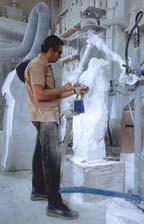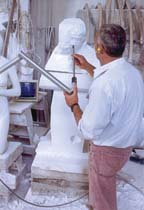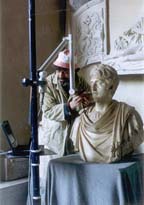
On Mount Altissimo, northeast of Carrara, Italy, a truck creeps down a zigzag road that was once climbed by Michelangelo. As it eases to the end of one track, the driver pauses at the switchback and proceeds in reverse down the next leg because the road is too narrow to make the turn. There is no guard rail or escape route. On the bed of the truck rides a pale, 12-ton chunk of marble bearing a magical name: “statuario.†Within the stone lies a secret that is waiting for the hands of an artisan to be set free.
For two millennia, men have done the dangerous work of quarrying marble from the flanks of Mount Altissimo and other nearby mountains in the Apuan Alps of Tuscany because it is unique. Dense and more fine-grained than Grecian or American marble, it can be carved to finer detail. But, it is its color that makes it so prized by sculptors. When chiseled and polished, the stone captures light, then gives it back in the shade of egg shell touched with a bit of ash and a warm drop of vanilla. It seems at once both sad and alive. Such is the stone that has brought men of genius and men of purpose to these mountains.

Studio “factoriesâ€
Based on this storied marble, a centuries-old industry of artisans has grown up in the villages that lay on the plane between the mountains and the Tyrrhenian Sea. In Massa, Querceta and Pietrasanta -- as well as Carrara -- sculptors have been converting the designs of artists into busts of men and women, figures of animals -- real and mythological -- abstract shapes, capitals for columns, fountains, and even images of cars.This partnership between artist and sculptor is likened to that of composer and orchestra; one creates and the other executes. It is essentially a process of scaling up models to full-sized images. Many of the pieces in marble revered from antiquity were produced through this relationship -- including the works of Cellini, Bernini, and Donatello -- and still adorn notable landmarks such as the Leaning Tower of Pisa, the Hermitage in St. Petersburg, Russia, and Kennedy Center in Washington, DC.
The symbiotic relationship continues just as lively today. Around the globe, artists turn their visions into plaster models known as maquettes, then send them to their studio partner in the Carrara region. To these maquettes, studio artisans tack small studs into the model at points that roughly define the object's shape. Then, using calipers, rulers and large sheets of paper, the artisans take measurements from these points and scale up the model to the size envisioned by the original artist. This arrangement allows an artist to concentrate on his vision, and to turn out far more works of art than he could finish himself if he had to perform the actual chiseling.
Improving the fidelity
However, using mechanical implements in the transfer of concept from maquette to finished piece can lead to problems with both proportion and detail of a sculpture. Measurements shifted a fraction of an inch can alter the appearance of a scroll, nymph or leaf. Part of the problem lies with the limited number of measurements that an artisan can take using mechanical implements.To eliminate confusion and to improve fidelity between maquette and finished sculpture, the marble studio di Stagetti Nicola of Pietrasanta replaced the classical model scaling technique with one that was developed in the late 20th Century. Instead of mechanical measuring implements, they now use a three-dimensional digital measuring arm, known as the FaroArm[r], that gives them an almost unlimited number of data points from a maquette. Made by FARO Technologies of Lake Mary, FL, the arm is an articulating measuring instrument -- portable coordinate measuring machine -- that uses optical encoders at the “joints†to track the exact position of a probe attached to the end of it. This arm is similar to the ones used in aircraft and automotive production to check the accuracy of machined and assembled parts, and to translate dimensions of clay models into metal shapes.
Using this instrument, di Stagetti artisans trace the shape of a maquette as a sequence of discrete points or as a continuous line of points. Detail as fine as a couple of thousandths of an inch can be recorded. These data are transferred to a computer where the image of the maquette is recreated as a CAD file. Then, using the computer to scale up the dimensions, the studio sculptor begins the task of removing marble and finding the image that the artist envisioned within the stone.
As he goes, he checks his work against the scaled up image by touching the arm stylus to various points of interest on the emerging statue. The software in the computer -- written to be the companion to the arm and known as CAM2 Measureâ„¢ -- compares the new point that he as taken with the original developed from the maquette, and shows, graphically, how much more material remains to be chiseled off.

Tough environment for digital equipment
It is said that even in the summer, the mountains around Carrara appear snow covered and the rivers run milky white from the dusty tailings of the quarries. In the studios, high-speed chisels produce more of the gritty powder that is a hostile environment for digital instruments.
The FaroArm used at di Stagetti Nicola seems unaffected by the dust or the occasional bump into a slab of marble. This is remarkable in that the arm is one of the early units produced by FARO, and has been in service in the Italian studio for seven years. However, it was designed to withstand the rigors of industrial production environment such as automotive assembly plants and metal-fabrication shops. The experience at di Stagetti Nicola indicates that it is very nearly impervious to a dusty environment as well.
A wide range of work
The studio at Pietrasanta uses the arm to turn out an extraordinary array of pieces, from pilasters and capitals for columns to fountains for gardens -- as well as statues and relief pieces from contemporary artists and replicas of ancient works. Some of their work is intended to be as much practical as decorative, such as borders for raised gardens or a set of carved steps. In any case, they are able to achieve optimum quality of detail.Since di Stagetti Nicola acquired the Gold FaroArm, FARO has released the Laser ScanArm. Unlike other scanning systems, the FARO ScanArm's hard probe and laser scanner can digitize interchangeably without having to remove either component, untangle cabling, or use a separate CMM then trying to import the data. There are no third-party attachments, no external electronics and no cables that interfere with the Arm's infinite rotation ability, so the users get maximum data handling, accuracy and efficiency in an affordable package - rather than the complications of integrating separate technologies.